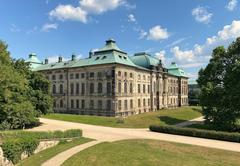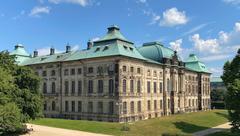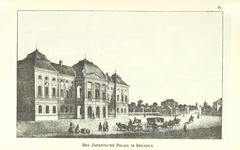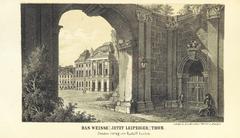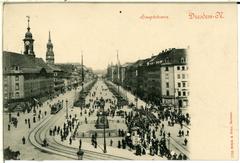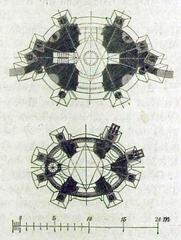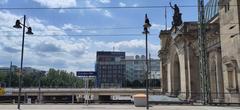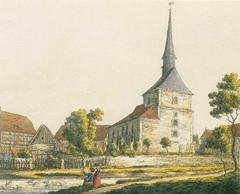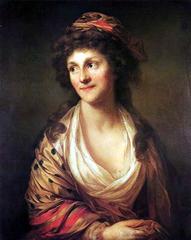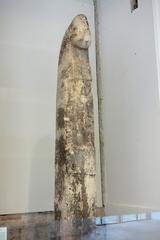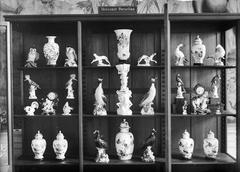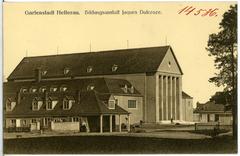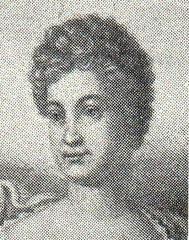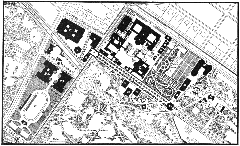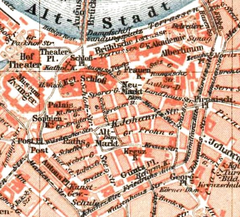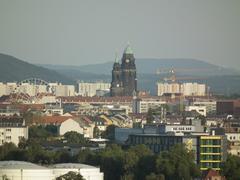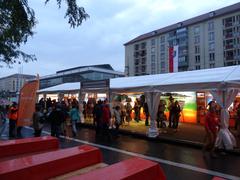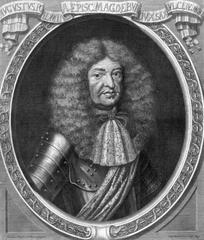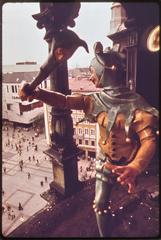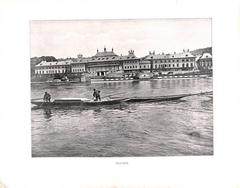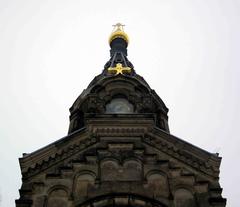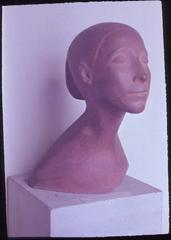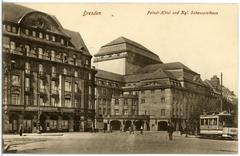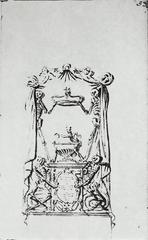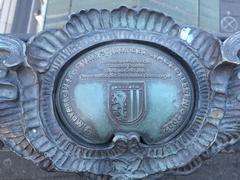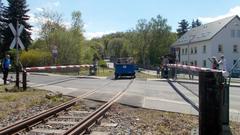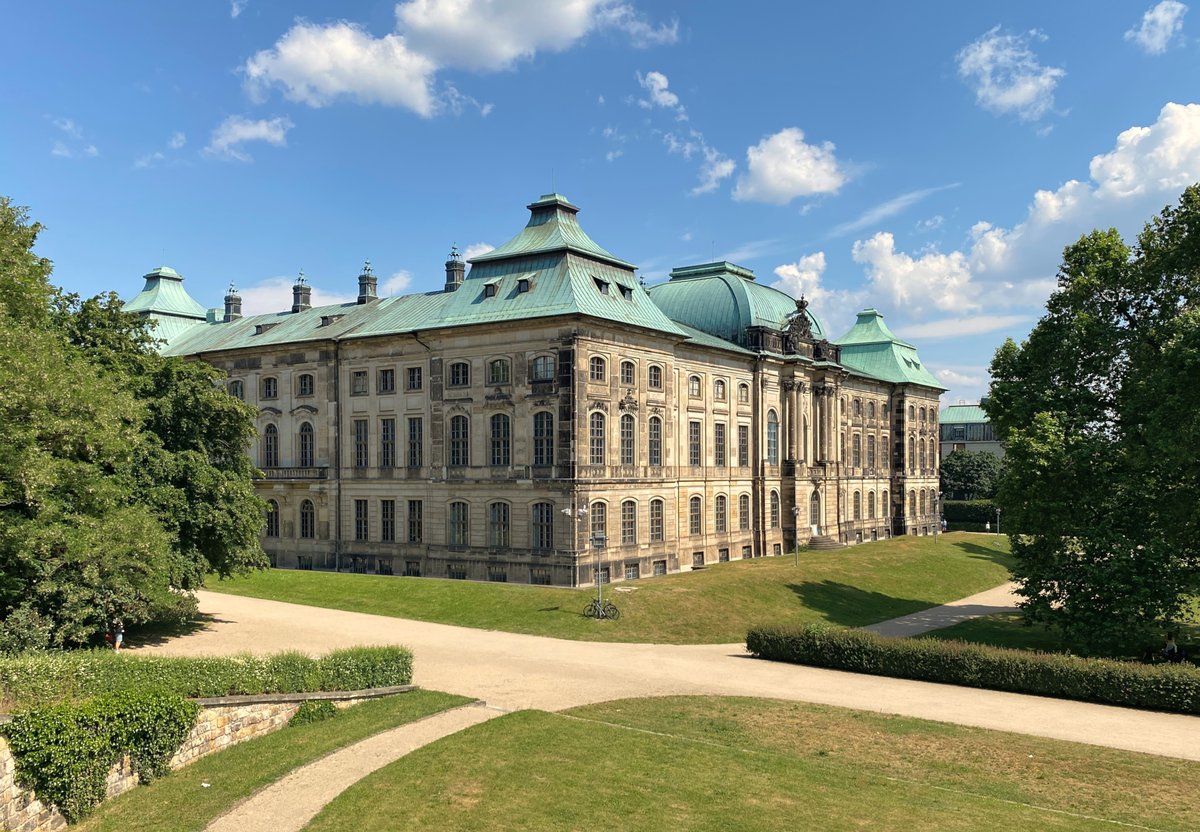
Japanisches Palais Dresden: Visiting Hours, Tickets, and Historical Significance Guide
Date: 14/06/2025
Introduction
Set along the scenic banks of the Elbe River in Dresden’s Neustadt district, the Japanisches Palais is an architectural and cultural jewel that bridges Baroque grandeur with East Asian-inspired design. Originally conceived in the early 18th century to house Augustus the Strong’s legendary porcelain collection, the palace has evolved into a vibrant center for art, history, and science. Visitors today can explore its multifaceted museums, attend lively cultural events, and enjoy tranquil gardens—all within one of Dresden’s most unique historic sites (Sachsens Schlösser; Spotting History).
This comprehensive guide details the palace’s fascinating history, architectural highlights, practical visiting information—including hours and tickets—plus expert tips for making the most of your experience.
Historical Overview
Origins and Early Development (1715–1727)
The Japanisches Palais began as a country house in 1715, designed by Matthäus Daniel Pöppelmann for Jakob Heinrich Graf von Flemming. Its transformation started when Augustus the Strong acquired the property in 1717, envisioning it as a showcase for his remarkable porcelain collection—a symbol of prestige in 18th-century Europe (Spotting History). The palace was initially known as the “Holländisches Palais,” reflecting its Dutch gardens and a brief Dutch residency.
Baroque Expansion and Architectural Significance (1727–1744)
Between 1727 and 1744, architects Pöppelmann, Zacharias Longuelune, and Jean de Bodt redesigned the building into a four-wing Baroque palace. Its iconic curved roofs and pagoda-like elements were a deliberate homage to East Asian aesthetics, underscoring the era’s fascination with global art and culture (Sachsens Schlösser). While the porcelain museum plan never fully materialized, the palace soon became a venue for court festivities, including the celebrated “Seven Planets Festivals” of 1719.
From Royal Library to Museum (1782–1945)
After suffering damage during the Seven Years’ War, the palace was repurposed as a cultural institution. Renovated by Count Marcolini in the late 18th century, it became home to the Electoral Library (later the Saxon State Library) and Dresden’s collection of antiquities. Notable architects, including Gottfried Semper, oversaw further adaptations to accommodate its museum and library roles (Sachsens Schlösser).
Wartime Destruction and Reconstruction (1945–1987)
The Japanisches Palais was heavily damaged during the 1945 bombing of Dresden (Spotting History). Restoration began in 1951 and continued in phases until 1987, preserving the palace’s Baroque character and restoring its gardens.
Contemporary Role
Today, the Japanisches Palais houses the Museum für Völkerkunde Dresden (Ethnological Museum), the State Museum for Pre-History, and the Senckenberg Natural History Collections. These institutions offer diverse exhibitions on world cultures, archaeology, and natural history, making the palace a central hub for cultural engagement (artsupp.com; SKD Museum).
Visiting the Japanisches Palais: Essential Information
Location
- Address: Palaisplatz 11, 01097 Dresden
- District: Neustadt, alongside the Elbe River (SKD Museum)
Opening Hours
- Tuesday–Sunday: 10:00 AM – 6:00 PM
- Closed: Mondays and select public holidays
- Tip: Always verify current hours on the official website, especially during special exhibitions or events.
Tickets and Admission
- General Admission: €8
- Reduced Admission: €5 (students, seniors, disabled)
- Children under 18: Free
- Family Ticket: €15 (2 adults + up to 3 children)
- Special Events: Prices vary (€23–€45 for concerts/theater, discounts available)
- Purchase: Online via the official website or at the entrance. Advance booking is highly recommended for popular events (Konzertkasse Dresden).
Accessibility
- Wheelchair Accessible: Elevators, ramps, and accessible restrooms available.
- Assistance: Staff can provide help; assistance dogs are welcome.
- Amenities: Cloakroom, lockers, baby changing stations, and multilingual information.
Getting There
- Public Transport: Tram lines 4 and 9 to “Palaisplatz” stop. Efficient connections to the city center and main train stations.
- By Car: Limited street parking nearby; public transport is recommended.
- Cycling: Bike racks available; scenic Elbe cycle path runs by the palace.
Visitor Experience and Practical Tips
What to Expect
- Museum Complex: Houses the Museum für Völkerkunde Dresden, State Museum of Pre-History, and Senckenberg Natural History Collections.
- Exhibitions: Explore global cultures (including the Damascus Room), archaeology, natural history, and special thematic exhibitions.
- Events: Regularly hosts concerts, theater (notably Shakespeare’s “Ein Sommernachtstraum” in 2025), workshops, and the beloved Palais Sommer festival (Palais Sommer).
- Gardens: Landscaped grounds ideal for strolls, relaxation, and photography.
Facilities
- Café: Offers light meals and refreshments with garden views (temporarily closed as of June 2025; check ahead).
- Restrooms: Accessible and equipped for families.
- Museum Shop: Sells books, gifts, and souvenirs inspired by the palace’s heritage.
Guided Tours and Audio Guides
- Languages: German and English tours available; audio guides for select exhibitions (official website).
Photography
- Allowed: In public areas and gardens for personal use.
- Restrictions: No flash, tripods, or selfie sticks in exhibition spaces; check signage for specific rules.
Family-Friendly
- Programs: Interactive exhibits, workshops, and safe garden spaces for children.
- Education: Activities often scheduled during school holidays.
Tips for Your Visit
- Check the calendar: For event dates and any changes to hours (Palais Sommer Program).
- Book early: Especially for concerts and festival events.
- Arrive early: For a quieter experience, especially on weekends.
- Wear comfortable shoes: For exploring both the palace and gardens.
- Stay hydrated: Bring a water bottle during summer.
- Follow museum rules: Regarding photography and food/drink.
Nearby Attractions
- Golden Horseman Statue: A short walk from the palace (tripclap.com).
- Brühl’s Terrace: Panoramic views of Dresden’s Altstadt.
- Albertinum Museum, Frauenkirche, and Zwinger Palace: Major art and historical sites within easy reach.
- Neustadt Quarter: Known for artisan arcades, shops, and vibrant local culture.
- Elbe Riverbanks: Ideal for cycling, walking, and picnics.
Frequently Asked Questions (FAQs)
Q: What are the Japanisches Palais visiting hours?
A: Tuesday to Sunday, 10:00 AM–6:00 PM; closed on Mondays and select holidays. Always confirm on the official website.
Q: How much do tickets cost?
A: General admission is €8; reduced rates are available. Some events are free, while concerts/theater can cost €23–€45.
Q: Is the palace wheelchair accessible?
A: Yes, with elevators, ramps, and accessible restrooms.
Q: Are guided tours available in English?
A: Yes, check availability at the ticket desk or online.
Q: Can I take photos inside?
A: Photography is allowed in public areas and gardens, with some restrictions in exhibitions.
Q: Are there family-friendly activities?
A: Yes, including workshops, interactive exhibits, and garden play spaces.
Visual Highlights
- Baroque Architecture: Distinctive curved eaves and East Asian motifs.
- Damascus Room: Exquisite 19th-century Syrian interior.
- Gardens: Perfect for photos and relaxation.
- Virtual Tours: Available via the official website.
Conclusion
The Japanisches Palais stands as a living testament to Dresden’s rich history, resilience, and cosmopolitan spirit. Its Baroque architecture, transcultural collections, and dynamic events offer something for every visitor, from history enthusiasts to families and art lovers. Make the most of your visit by checking current opening hours and ticket information online, booking guided tours, and exploring both the palace and its vibrant surroundings.
Stay up to date on exhibitions, events, and visitor resources by exploring the official website and downloading the Audiala app for interactive guides.
Related Articles and Further Reading
- Explore Dresden’s Baroque Architecture
- Top Museums to Visit in Dresden
- Guide to Dresden’s Historic Old Town
Sources
- Visiting the Japanisches Palais in Dresden: History, Tickets, and Travel Tips, 2025, Sachsens Schlösser (Sachsens Schlösser)
- Japanisches Palais Visiting Hours and Tickets: A Guide to Dresden’s Historic Monument, 2025, Official SKD Museum (Japanisches Palais SKD)
- Japanisches Palais Dresden: Visiting Hours, Tickets, and Cultural Highlights, 2025, Artsupp (artsupp.com)
- Visitor Information and Practical Tips, 2025, The Tourist Checklist (The Tourist Checklist)
- Spotting History: Japanisches Palais History, 2025 (Spotting History)
